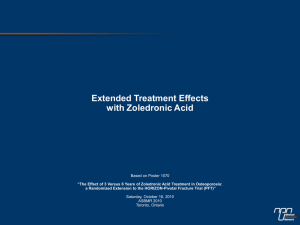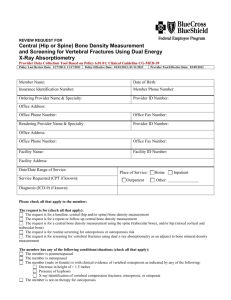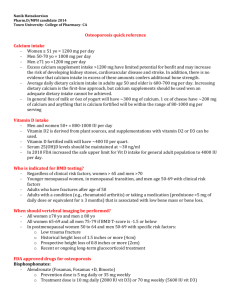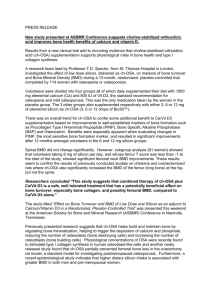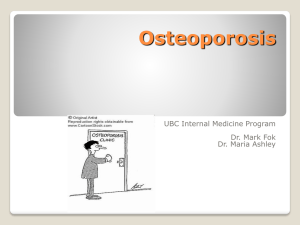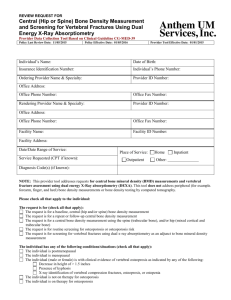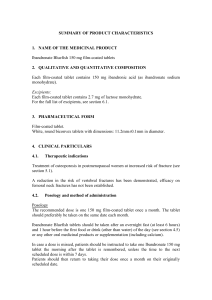Incidence and Predictors of Vertebral Fractures in the Lebanese
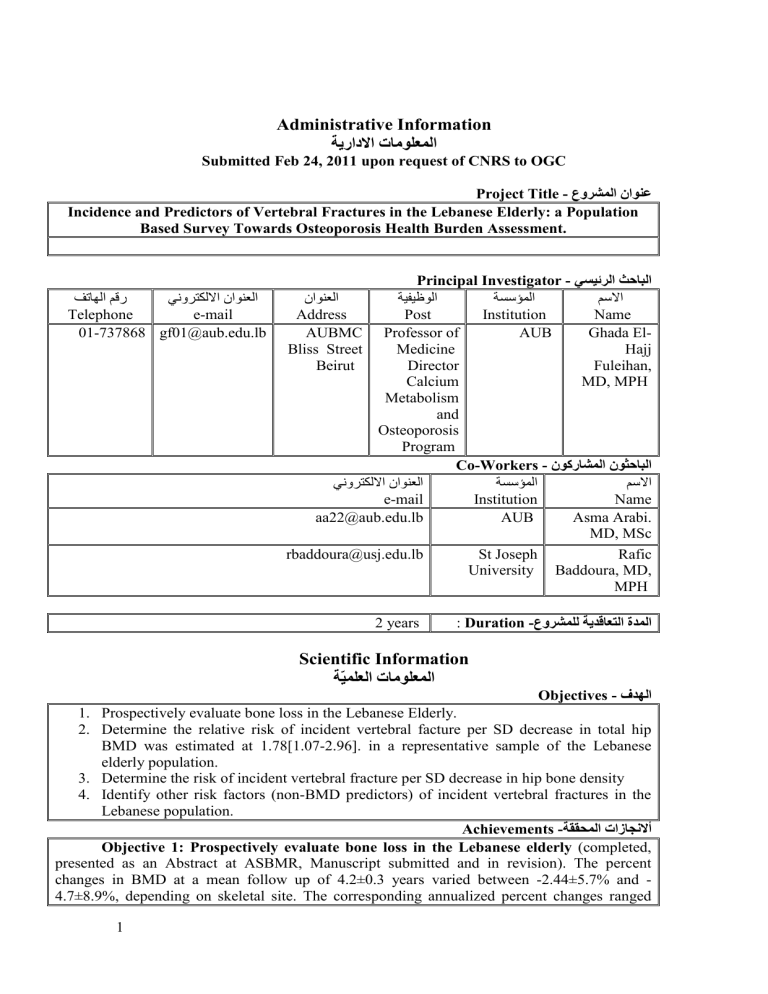
Administrative Information
ةيرادلاا تامولعملا
Submitted Feb 24, 2011 upon request of CNRS to OGC
Project Title -
عورشملا ناونع
Incidence and Predictors of Vertebral Fractures in the Lebanese Elderly: a Population
Based Survey Towards Osteoporosis Health Burden Assessment.
فتاهلا مقر
Telephone
01-737868
ينورتكللاا ناونعلا e-mail gf01@aub.edu.lb
ناونعلا
Address
ةيفيظولا ةسسؤملا
Principal Investigator - يسيئرلا ثحابلا
مسلاا
Post Institution Name
AUBMC
Bliss Street
Beirut
Professor of
Medicine
Director
Calcium
Metabolism and
AUB Ghada El-
Hajj
Fuleihan,
MD, MPH
Osteoporosis
Program
ينورتكللاا ناونعلا
Co-Workers -
نوكراشملا نوثحابلا
ةسسؤملا مسلاا e-mail Institution Name aa22@aub.edu.lb
AUB Asma Arabi.
MD, MSc rbaddoura@usj.edu.lb
St Joseph
University
Rafic
Baddoura, MD,
MPH
:
Duration -
عورشملل ةيدقاعتلا ةدملا
2 years
Scientific Information
ةّيملعلا تامولعملا
Objectives فدهلا
1.
Prospectively evaluate bone loss in the Lebanese Elderly.
2.
Determine the relative risk of incident vertebral facture per SD decrease in total hip
BMD was estimated at 1.78[1.07-2.96]. in a representative sample of the Lebanese elderly population.
3.
Determine the risk of incident vertebral fracture per SD decrease in hip bone density
4.
Identify other risk factors (non-BMD predictors) of incident vertebral fractures in the
Lebanese population.
Achievements -
ةققحملا تازاجنلاأ
Objective 1: Prospectively evaluate bone loss in the Lebanese elderly (completed, presented as an Abstract at ASBMR, Manuscript submitted and in revision). The percent changes in BMD at a mean follow up of 4.2±0.3 years varied between -2.44±5.7% and -
4.7±8.9%, depending on skeletal site. The corresponding annualized percent changes ranged
1
from -0.58±1.3% to -1.11±2.1%. There was no significant difference in BMD changes between men and women except at the femoral neck where bone loss was more pronounced in women
(-3.7% vs -0.8, p=0.02%).
Objective 2: Incidence of vertebral fractures (completed, manuscript in preparation) :
At baseline, prevalence of radiographic vertebral fractures was 12.1% [7.7-17.7], comparable in both genders: 12.6% [7.2-19.9] in women and 11.1% [4.6-21.6] in men. At follow-up, prevalence of radiographic vertebral fractures increased to 19.8% [14.3-26.3] in the overall group, 17.7% [11.3-25.7] in women and 23.8% [14.0-36.2] in men (p=0.321). The cumulative incidence of vertebral fractures was 8.2% [4.7-13.2] in the whole cohort.
Incidence was higher in men 12.7% [5.6-23.5] than in women 5.9% [2.4-11.7], although the difference was not statistically significant between genders (p=0.112).
Incident non-vertebral fractures were reported by 7 subjects [3.9% (1.5-7.8)]. Six were females. Three fractures involved the hip.
Objective 3: RR/SD decrease in total hip BMD (completed, paper in submission):
The relative risk of incident vertebral facture per SD decrease in total hip BMD was estimated at 1.78[1.07-2.96], a risk estimate comparable to data published in other Caucasian populations and used worldwide for fracture risk assessment in the WHO FRAX fracture risk calculator.
Objective 4: Identify other risk factors, (non-BMD predictors) of incident vertebral fractures in the Lebanese population (completed, presented as an Abstract at ASBMR, manuscript submitted and now in revision). Age correlated negatively with percent changes in
BMD at all skeletal sites (p< 0.05). Changes in BMI and in body composition correlated positively with changes in BMD at all sites, except at the forearm. Conversely, PTH negatively correlated with changes in BMD at all skeletal sites (r = -0.14 to -0.27, p < 0.05). This correlation persisted after adjustment for age, changes in BMI, changes in fat mass and lean mass, serum creatinine, calcium intake and 25-OHD levels. PTH level alone explained 3% of the variance in BMD changes at all hip sub-regions.
Perspectives - ثحبلا قافآ
The work resulting from this project has resulted in several original publications, listed below and contributed in part to the materials used for the work-review compiled by Task Forces appointed by International bodies, which the PI and Co-PI of this project partake in as Chairs,
Co-Chairs or Task Force members. This includes WHO EMRO for regional osteoporosis guidelines and the WHO collaborating Center for Metabolic Bone Disorders, the International
Osteoporosis Foundation (IOF) for the Middle East &Africa Osteoporosis Audit and both the
IOF and the International Society of Clinical Densitometry (ISCD) for the FRAX International
Initiative.
The work is thus of major epidemiologic and public health relevance not only to Lebanon but also to the regional and global perspective and guidance generated by International organizations and authorities regarding health care for osteoporosis and other metabolic bone disorders .
2
Publications & Communications -
تارمتؤملا يف تامهاسملاو تاروشنملا
Publications in first tier peer reviewed specialty bone journals:
1.
Asma Arabi, Rafic Baddoura, Rola El-Rassi, Ghada El-Hajj Fuleihan. PTH level but not 25 (OH)
Vitamin D level Predicts Bone Loss rates in the Elderly. In revision for Osteoporosis
International.
2.
Baddoura R, Hoteit M, El-Hajj Fuleihan G. Osteoporotic fractures, DXA and fracture risk assessment: meeting future challenges in the Eastern Mediterranean Region. In revision Journal of
Clinical Densitometry
3.
Baddoura R, El-Hajj Fuleihan G . Changes in lean mass, fat mass and bone density and incident vertebral fractures. In preparation.
Abstract presentations at international meetings:
1.
Arabi A, Zahed L, Mahfoud Z, Maalouf J, Nabusli M, Choucair M, El-Hajj Fuleihan G*. Lack of Major
Survival Benefit of Vitamin D Receptor Gene Polymorphisms. 29th Annual Meeting of the American
Society for Bone and Mineral Research (ASBMR), Honolulu, 16-19 September 2007.
2.
El-Hajj Fuleihan G, Baddoura R, Awada H, Arabi A. Osteoporosis and hypovitaminosis D in the Lebanese elderly: a population based study. 14 th Annual Meeting of the International Society of Clinical
Densitometry, San Francisco, California, 12-15 March 2008.
3.
Arabi A, El-Rassi R, El-Hajj Fuleihan G*. The negative relationship between PTH and vitamin D: is there an age and a gender effect? 30 th ASBMR meeting, 12-15 Sept 2008.
4.
Arabi A, Baddoura R, El-Hajj Fuleihan G*. PTH and not vitamin D predicts age related bone loss in the elderly: a prospective population-based study. 30 th
ASBMR meeting, 2008.
5.
Arabi A, Baddoura R, El-Hajj Fuleihan G*. PTH and not vitamin D predicts age related bone loss in the elderly: a prospective population-based study. ESCEO Meeting, March Athens, 2009.
Invited poster.
6.
El-Hajj Fuleihan G, Arabi A, Ghalayini T, El-Rassi R, Baliki G, and Kassem M.
DLK1/FA1 and parameters of bone metabolism and body composition in the elderly. 31 st
ASBMR meeting, Denver,
USA, September 2009. Plenary Poster.
7.
Baddoura R, El-Hajj Fuleihan G. Should we still use population specific BMD databases for osteoporosis assessment in the eastern Mediterranean region? Pan Arab Rheumatology meeting,
Amman, Jordan, April 2010.
3
Abstract -
ثحبلا جئاتن نع زجوم
ABSTRACT: as originally submitted with project
Achievements outlined above under achievements.
Osteoporosis affects one third of women in the United States and is of increasing social and economic importance as the size of the aging population continues to grow. It is projected that the magnitude of the problem may be even larger in developing countries including the
Middle-East where the relative increase in the elderly population is expected to be higher than developed countries. Current WHO definition of osteoporosis is based on T-score estimation that is the standardized difference between an individual’s bone mineral density (BMD) and the average BMD of young adults or peak BMD of the same population. In a recent study by our group evaluating a representative sample of young healthy Lebanese subjects we observed that peak BMD is lower in Lebanese subjects compared to American-European counterparts. Yet the significance of this lower peak BMD on the epidemiology of osteoporotic fractures in
Lebanon is still unknown. Furthermore, we have estimated the prevalence of osteoporotic fracture on a population-based random sample of elderly individuals.
Estimating vertebral fractures incidence in our elderly population, will be further step in the validation of the fracture-BMD relationship, on which guidelines for diagnosis and intervention are based worldwide and the derivation of estimates for osteoporotic fracture risk in our country. The objectives of this proposal are: a-To prospectively evaluate bone loss in the Lebanese Elderly. b- To determine the incidence of vertebral fractures in a representative sample of the Lebanese elderly population broken-down by decade [65-75 years, 75-85 years] and gender based on radiological criteria for vertebral fracture assessment. c-To determine the risk of incident vertebral fracture per SD decrease in bone density. d-To identify other risk factors (non-BMD) predictors of incident vertebral fractures in our population.
All of the above objectives will further our understanding of the extent and impact of osteoporosis as a public health problem in Lebanon, but as importantly allow comparison of our local data to comparable international estimates, and therefore validate the application of internationally derived osteoporosis guidelines to our local population, including fracture risk assessment models.
4

